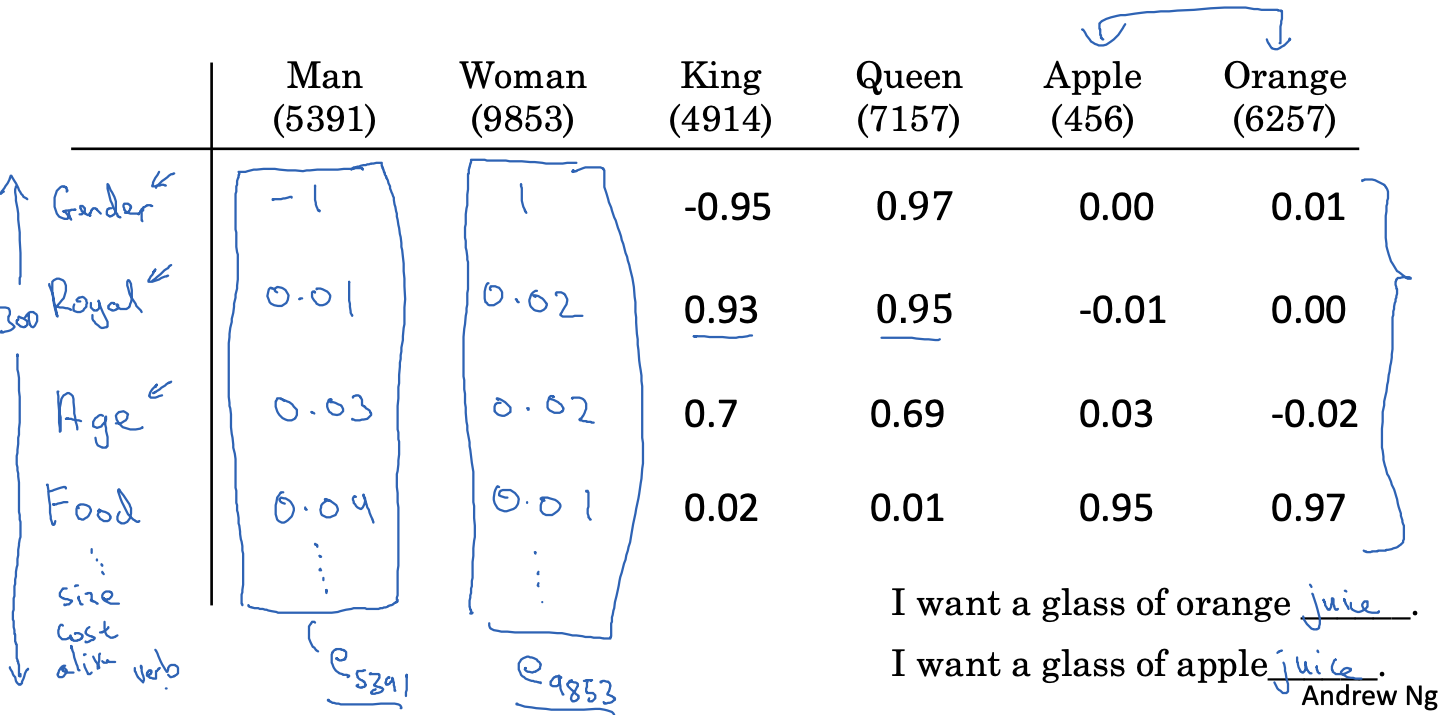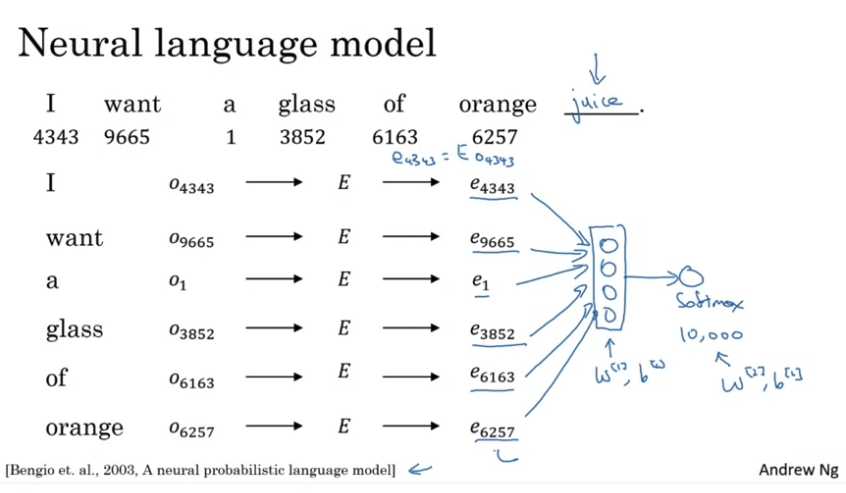NLP and Word Embeddings
Word Embeddings
之前我们将输入文本用一个 1 hot vector 来表示,它是建立在一个 dictionary 的基础上,比如单词man的表示方式为
[0, 0, 0, ..., 1, ..., 0, 0]
1表示其在 dictionary 中的 index,我们用$O_{index}$表示。上面例子中,man在字典中的 index 为 5791,则对应的表示为${O_{5791}}$。不难发现,对任意两个不同的 word,他们所对应向量之间的 inner product 为0。这说明 word 之间完全正交,即使他们有相关性,系统也无法 generalize,例如
I want a glass of orange juice
I want a glass of apple ____
即使系统可以推测出orange juice,但是当下次遇到 apple时,由于apple和orange正交,则之前的结果无法 generalize 到 apple 上面,此时还需要计算得到 apple juice,效率非常低。因此我们可以换一种形式来表示一个 word。
我们可以给字典里的每个 word 关联一些 feature,比如

图中我们为每个 word 关联了 300 个 feature,因此每个 word 可以用一个[300, 1]的 vector 表示,对于单词Man所对应的 vector,我们用 $e_{5391}$ 来表示。这样两个相似的 word,他们的 feature vector 也是相似的,比如Apple和Orange。
回到最开始 RNN 的那个例子,假设我们有一个句子,我们需要识别出那些 word 是人名
x = ["Sally", "Johnson", "is", "an", "orange", "farmer"]
y = [1, 1, 0, 0, 0, 0]
之前每个 word 使用 1 hot vector 来表示,现在则可以用 word embedding 来表示。那么 word embedding 从哪里来呢?我们需要自己训练 model 来得到每个 word 的 embedding,当然也可以下载已经训练好的。实际上,对于每个 word 来说,我们可以想象将其 encode 成一个 vector,即 embedding。我们可以用一个很大的 unlabled text 数据集来 train 我们的 embedding model,然后在 transfer learning 到一个 small dataset 上面:
- learn word embeddings from a large text corpus (1-100B words)
- (Or download pre-trained embedding online)
- Transfer embedding to new task with smaller training set (say, 100k words)
- Optional: Continue to finetune the word embeddings with new data.
Embedding Matrix
假设我们的字典有10,000个单词,每个单词的 feature vector 是[300, 1],那么整个 embedding matrix 为[300, 10,000],每一个列向量代表一个词所有的 feature,我们的目标就是 train 我们的 network 来找到这个 embedding matrix
如果我们用这个 embedding matrix E (300, 10,000) 去和一个 one-hot vertor O(10,000, 1)相乘,结果是一个(300, 1)的 vector e

Word2Vec
Word2Vec 是一种相对比较高效的 learn word embedding 的一种算法。它的大概意思,选取一个 context word,比如”orange” 和一个 target word 比如 “juice”,我们通过构建 neural network 找到将 context word 映射成 target word 的 embedding matrix。通常来说,这个 target word 是 context word 附近的一个 word,可以是 context word 向前或者向后 skip 若干个 random word 之后得到的 word。
如果从 model 的角度来来说,它的 input 是一个 word,output 是它周围的一个 context word。
还是假定我们的字典大小为10,000,每个 feature vector 的 dim 是300,那么 embedding 的 matrix 大小为[10,000, 300],我们的输入用 word 的 1-hot vector 表示,即是一个[10,000, 1]的稀疏向量,则我们 model 定义如下
# for each input word, predict its context words surrounding it
class SkipGram(nn.Module):
def __init__(self, n_vocab, n_embed):
super().__init__()
# complete this SkipGram model
self.embedding = nn.Embedding(n_vocab, n_embed)
self.fc = nn.Linear(n_embed, n_vocab)
self.softmax = nn.LogSoftmax(dim=1)
def forward(self, x):
x = self.embedding(x)
x = self.fc(x)
x = self.softmax(x)
return x
Negative Sampling
上面的SkipGram有一个性能问题是如果字典数量过大会导致 softmax 方法非常耗时。这里介绍另一种相对高效的 network,叫做 Negtive Sampling。它的大概意思是,给一组 context word 和 target word,判断他们是否是符合语义,比如
x1: (orange, juice), y1:1
x2: (orange, king), y2:0
选取这个 pair 的方式和上面一样,sample 一下 context word,然后随机选取某一个 context word 周围一个 word(window 可以是左右 10 个 word 以内)作为 target word。
因此,我们 model 变成了一个 logistic regression model,它的 input 是一个 pair,output 是0或1用来表示这个 pair 是否正确。
context_embed = nn.Embedding(n_vocab, n_embed)
target_embed = nn.Embedding(n_vocab, n_embed)
P(y=1 | c,t) = sigmoid(target_embed.t() * context_embed)
当我们 train 这个 model 的时候,我们的 training dataset 需要有 negative examples:
context | word | target?
--------------------------
orange | juice | 1
range | king | 0
orange | book | 0
orange | the | 0
orange | of | 0
但实际上我们 train 的时候,y不需要包含 10,000 个结果,而只需要K个,其中K-1个为 negative example,K可以为 4
GloVe (global vectors for word representation)
TBD
